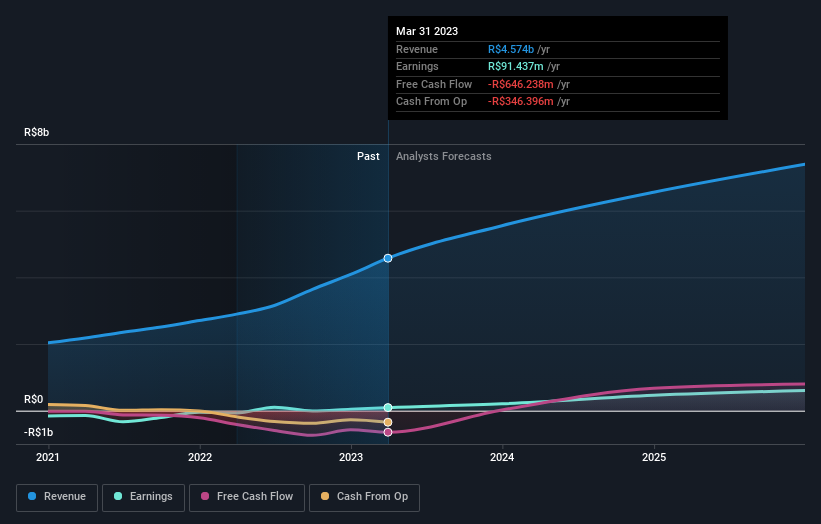With 77% ownership in Oncoclínicas do Brasil Serviços Médicos S.A. (BVMF:ONCO3), institutional investors have a lot riding on the business
Key Insights
- Significantly high institutional ownership implies Oncoclínicas do Brasil Serviços Médicos' stock price is sensitive to their trading actions
- 64% of the company is held by a single shareholder (Cultinvest Asset Management Ltda)
- Analyst forecasts along with ownership data serve to give a strong idea about prospects for a business
To get a sense of who is truly in control of Oncoclínicas do Brasil Serviços Médicos S.A. (BVMF:ONCO3), it is important to understand the ownership structure of the business. We can see that institutions own the lion's share in the company with 77% ownership. Put another way, the group faces the maximum upside potential (or downside risk).
And as as result, institutional investors reaped the most rewards after the company's stock price gained 4.2% last week. The gains from last week would have further boosted the one-year return to shareholders which currently stand at 112%.
Let's take a closer look to see what the different types of shareholders can tell us about Oncoclínicas do Brasil Serviços Médicos.
Check out our latest analysis for Oncoclínicas do Brasil Serviços Médicos

What Does The Institutional Ownership Tell Us About Oncoclínicas do Brasil Serviços Médicos?
Many institutions measure their performance against an index that approximates the local market. So they usually pay more attention to companies that are included in major indices.
As you can see, institutional investors have a fair amount of stake in Oncoclínicas do Brasil Serviços Médicos. This can indicate that the company has a certain degree of credibility in the investment community. However, it is best to be wary of relying on the supposed validation that comes with institutional investors. They too, get it wrong sometimes. If multiple institutions change their view on a stock at the same time, you could see the share price drop fast. It's therefore worth looking at Oncoclínicas do Brasil Serviços Médicos' earnings history below. Of course, the future is what really matters.

Investors should note that institutions actually own more than half the company, so they can collectively wield significant power. We note that hedge funds don't have a meaningful investment in Oncoclínicas do Brasil Serviços Médicos. The company's largest shareholder is Cultinvest Asset Management Ltda, with ownership of 64%. This essentially means that they have extensive influence, if not outright control, over the future of the corporation. In comparison, the second and third largest shareholders hold about 2.9% and 2.7% of the stock. Bruno Ferrari, who is the third-largest shareholder, also happens to hold the title of Vice Chairman.
While studying institutional ownership for a company can add value to your research, it is also a good practice to research analyst recommendations to get a deeper understand of a stock's expected performance. There are a reasonable number of analysts covering the stock, so it might be useful to find out their aggregate view on the future.
Insider Ownership Of Oncoclínicas do Brasil Serviços Médicos
The definition of an insider can differ slightly between different countries, but members of the board of directors always count. Company management run the business, but the CEO will answer to the board, even if he or she is a member of it.
Most consider insider ownership a positive because it can indicate the board is well aligned with other shareholders. However, on some occasions too much power is concentrated within this group.
Shareholders would probably be interested to learn that insiders own shares in Oncoclínicas do Brasil Serviços Médicos S.A.. This is a big company, so it is good to see this level of alignment. Insiders own R$164m worth of shares (at current prices). It is good to see this level of investment by insiders. You can check here to see if those insiders have been buying recently.
General Public Ownership
The general public, who are usually individual investors, hold a 21% stake in Oncoclínicas do Brasil Serviços Médicos. While this group can't necessarily call the shots, it can certainly have a real influence on how the company is run.
Next Steps:
I find it very interesting to look at who exactly owns a company. But to truly gain insight, we need to consider other information, too. Consider for instance, the ever-present spectre of investment risk. We've identified 2 warning signs with Oncoclínicas do Brasil Serviços Médicos (at least 1 which is significant) , and understanding them should be part of your investment process.
Ultimately the future is most important. You can access this free report on analyst forecasts for the company.
NB: Figures in this article are calculated using data from the last twelve months, which refer to the 12-month period ending on the last date of the month the financial statement is dated. This may not be consistent with full year annual report figures.
Have feedback on this article? Concerned about the content? Get in touch with us directly. Alternatively, email editorial-team (at) simplywallst.com.
This article by Simply Wall St is general in nature. We provide commentary based on historical data and analyst forecasts only using an unbiased methodology and our articles are not intended to be financial advice. It does not constitute a recommendation to buy or sell any stock, and does not take account of your objectives, or your financial situation. We aim to bring you long-term focused analysis driven by fundamental data. Note that our analysis may not factor in the latest price-sensitive company announcements or qualitative material. Simply Wall St has no position in any stocks mentioned.
- RDW
- 12.18
- +11.23%
 Index Options
Index Options CME Group
CME Group Nasdaq
Nasdaq Cboe
Cboe TradingView
TradingView Wall Street Journal
Wall Street Journal